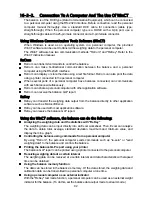
96
21. Terms/Index
21-1. Terms
Calibration
Adjustment of the balance so that it can weigh accurately.
Calibration weight
A weight used for calibration
Data number
Numbers assigned sequentially when weighing data or unit weight is
stored.
Digit
The minimum weighing value available. Used for the balance, one digit
is the smallest mass that can be displayed.
Environment
Ambient conditions such as vibration, drafts, temperature, static
electricity and magnetic fields which affect the weighing operation.
External weight
The weight that you have.
GLP
Good Laboratory Practice.
Internal mass
Built-in calibration weight
IP-65
IP code: Degree of protection provided by enclosures.
6: Dust-tight. No ingress of dust. 5: Protect against water jets.
Mode
Balance operational function.
Output
To output the weighing data using the RS-232C interface.
Range
A combination of weighing range and resolution.
Repeatability
Variation in measured values obtained when the same mass is placed
and removed repetitively. Usually expressed as a standard deviation.
Example: Standard deviation = 1 digit: This means that measured
values, obtained when the same sample is placed and removed
repetitively, fall within ±1 digit in the frequency of about 68%.
Re-zero
To set the display to zero.
Sensitivity drift
An affect that a change in temperature causes to the weighing data.
Expressed as a temperature coefficient.
Example: Temperature coefficient = 2 ppm/°C : If a load is 8 kg and the
temperature changes by 10°C, the value displayed changes by the
following value.
0.0002%/°C x 10°C x 8 kg = 0.16 g
In this example, if the value displayed is 8000.00 g before temperature
changes, a temperature change of 10°C will make the value displayed
8000.16 g.
Smart range function
The function allows weighing in the precision range, even if a heavy
tare is used.
Содержание GF-30K
Страница 7: ...5...
Страница 95: ...93 20 1 External Dimensions Unit mm...
Страница 102: ...100 MEMO...
Страница 103: ......
Страница 104: ......







































